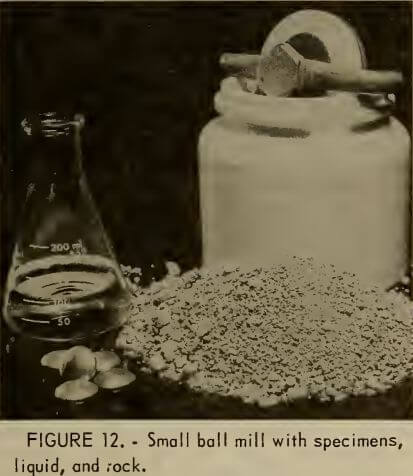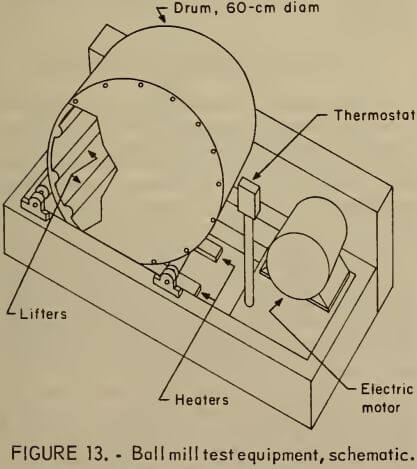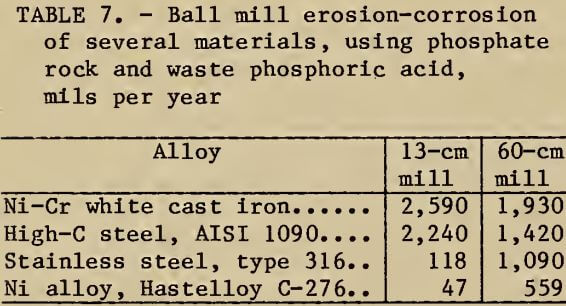Table of Contents
When a lump of ore is crushed by the impact between two balls in a ball mill, it is considered high-stress, three-body abrasive wear. The abrasive wear of balls that results from the milling of ore is the major wear loss in most minerals processing plants. During the wet milling of ores, abrasive wear is combined with corrosion. Abrasion and corrosion are synergistic: a corroded surface is more easily abraded than an abraded surface and an abraded surface is more easily corroded than a corroded passivated surface. Thus, each enhances the other. Natarajan showed that abrasive wear loss was much greater than corrosion loss on steel balls during the laboratory ball milling of magnetic taconite. Bond reported that wear rates during grinding became extreme as the pH of the liquid dropped below 5.5. Ellis did extensive tests on the effect of pH and atmosphere on steel balls while wet grinding sand in small 0.3- and 1-m-diam mills. Norman and Loeb extended the work to include the grinding of molybdenum ore in 3-m-diam mills.
The Bureau set up an apparatus to study wear caused by erosion-corrosion of specific ores and liquids. Two sizes of mills are used, a small mill, 12 cm ID, and a larger mill, 60 cm ID. The smaller mill is more convenient for laboratory research, but the surface of the test specimens may passivate because the small impacts may not significantly abrade the protective layer. That is, synergism may not occur. The larger mill assures more aggressive abrasion that is closer to the conditions in commercial mills.
Ball Mill Equipment and Specimens
The small ball mill is a commercial 12- cm-diam porcelain mill with five silicone rubber lifters added inside. The drive rotates the mill at 120 rpm. Figure 12 shows the mill with typical specimens, rock, and liquid for a run.
The larger ball mill (fig. 13), is 60 cm in diam by 20 cm long. It was fabricated from steel and lined with natural rubber, 1 cm thick. The interior of the mill has 12 lifters, each 2 cm high. In operation, the mill is entirely closed except for a vent in the center to prevent buildup of gas pressure. One end of the mill can be unbolted and removed for loading specimens, rock, and liquid. The mill is rotated by two rollers driven by a 2.7-kW motor that drives the mill at 43 rpm or 75 pct of critical speed. A wooden cover fits over the mill and drive


assembly. A heater and thermostat within maintain constant temperature during a run.
The specimens used in the small ball mill are oblate spheroids about 2 cm in diam by 1 cm thick. Specimens of a wide range of alloys are conveniently prepared in an inert atmosphere box by arc-melting the starting materials on a copper hearth plate. The surface finish of such specimens is relatively smooth and requires little or no further grinding before testing.
The test specimens used in the larger mill are cylinders, 5 cm in diam by 5 cm long, that are conveniently made by cutting commercial 5-cm rods into 5-cm lengths. Noncommercial alloys are made by casting in a sand mold. The cast specimens are sandblasted and rough ground.
Ball Mill Procedure
To conduct a test in either ball mill, specific amounts of liquid and ore or rock are selected to provide a slurry. The ratio of ore weight to total surface area of the specimens is kept the same in both mills for comparison of results. Typically, 1.13 L of liquid, 3.8 L of ore, and six specimens are used in the larger ball mill. Test specimens are cleaned, dried, and weighed. The ore is put into the mill and is warmed to the desired operating temperature, normally 35° C. The test specimens and liquid are added to the ore, and the temperature and pH are measured. The mill is then sealed and run at constant temperature. After 1 h of running time, the mill is opened, the temperature of the slurry is measured, and the specimens are removed and cleaned with water and a soft nylon brush. A sample of the slurry is filtered, and the pH is measured. The tests on a given material are repeated until a consistent trend in weight loss is obtained. The surface area of each specimen is determined, and from the density and mass loss during the test time, the erosion-corrosion rate in mils per year (1 mil = 0.001 in) is calculated.
Ball Mill Results and Discussion
A study of erosion-corrosion of grinding media during the grinding of Florida phosphate rock with recycled waste phosphoric acid showed some characteristics of the two ball mills. This slurry was quite acidic, ranging from an initial pH of 2 to a final pH of 3 after the 1-h test. Erosion-corrosion wear data on four alloys are given in table 7. Corrosion-resistant materials, the nickel-base alloy, Hastelloy C-276, and the stainless steel, type 316, had good wear resistance in the small ball mill where impacts were small. In the large ball mill, however, the wear rate increased about 10 times. Apparently the larger mill produced impacts sufficient to remove the passivated film, thereby allowing an erosion-corrosion synergism. The data show that the large ball mill should give a more accurate correlation with industrial wet-grinding mills.

